Reporting team: Babar Ali Awan, Amer Malik, Naseem Hameed Yousafzai, Shahina Maqbool and Javed Ali
After the initial breakout reported in the Chinese city of Wuhan earlier this year, the novel coronavirus has spread to nearly every corner of the world, bringing life to a standstill for large swathes of the global population.
With scientists still unsure about how to stop it, routine life has been disrupted, people confined to their homes and economies turned upside down by the disease known as COVID-19 as it ravages the human civilization and wreaks havoc wherever it goes.
In Pakistan, after a halfhearted early decision to lock down soon gave way to a hurried easing of restrictions once the pandemic's impact became evident on the economy, the daily number of cases has registered sharp increases as the citizenry makes an attempt to return to normalcy.
This special report examines the current situation in Sindh, Punjab, Balochistan, Khyber Pakhtunkhwa and the federal capital and provides a snapshot of where Pakistan's healthcare system stands as the feared peak of infections nears.
Sindh: Number of available beds at hospitals running out
Currently, COVID-19 patients are being at treated 23 public and private hospitals in Sindh. The total number of isolation beds for the COVID-19 patients in these hospitals is 1,214 while a total of 351 beds have been arranged in the high dependency units (HDUs). The number of ventilators available at the intensive care units (ICUs) of these hospitals for COVID-19 patients is 257.
Right now, COVID-19 patients have occupied 201 isolation beds in Sindh while 1,013 beds are still available for new patients. Similarly, 200 HDU beds have been occupied and 151 HDU beds are available. Of the 257 ventilators for the COVID-19 patients in the province, 159 are being currently utilised and 98 are available for new patients.
Among all the cities in Sindh, Karachi is facing the most pressure in terms of its health care infrastructure for COVID-19 patients as only 30 ventilators, 67 HDU beds and 171 isolation beds are available in the city for new patients.
Around 92 per cent of COVID-19 patients in Sindh have isolated themselves at their homes. The number of such patients is 14,910. Meanwhile, 99 patients are being looked after in the isolation centre and 1,170 treated at the hospitals.
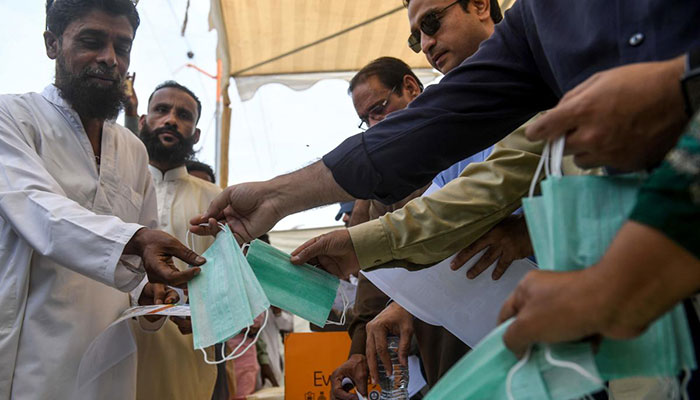
As the number of available beds at the hospitals has been decreasing with more and more patients getting admitted to the health facilities, new COVID-19 patients have been facing severe issues. Many hospitals do not have any further space for new COVID-19 patients, due to which they refer new patients to other hospitals. However, many a time, the other hospitals also excuse them because of no available beds.
There is a need for a referral system in these circumstances. If the Sindh government establishes a system through which patients can get information at home regarding availability of beds and ventilators at the hospitals, they can reach the right health facility in case of an emergency without delay and therefore, the chances of their survival will be higher.
According to the Sindh health department, Civil Hospital Karachi, Shaheed Mohtarma Benazir Bhutto Accident and Trauma Centre, Dow University Ojha Campus, Jinnah Postgraduate Medical Centre, Sindh Government Services Hospital Karachi, Lyari General Hospital, National Institute of Child Health (NICH), Indus Hospital, Sindh Institute of Urology and Transplantation (SIUT), Dr Ziauddin Hospital Clifton, Dr Ziauddin Hospital North Nazimabad and Aga Khan University Hospital (AKUH) have been treating COVID-19 patients in Karachi.
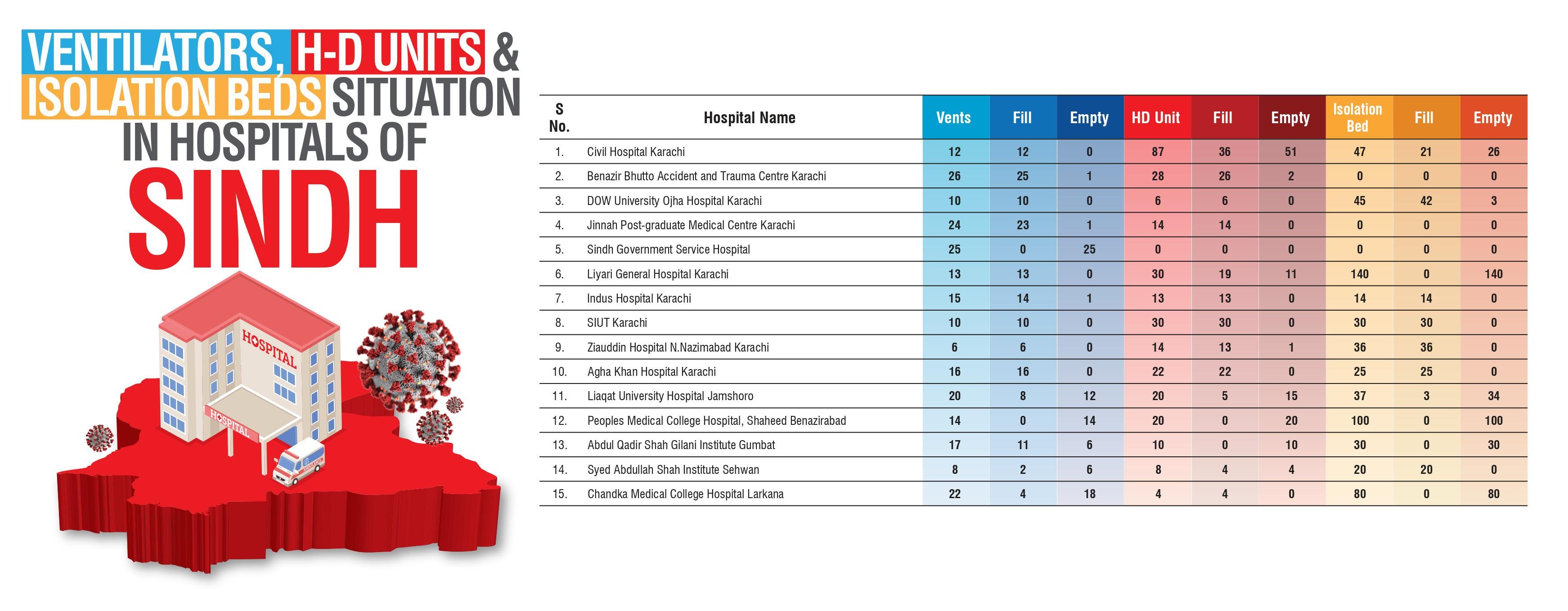
In the rest of Sindh, COVID-19 patients are receiving treatment at Liaquat University Hospital Jamshoro, Institute of Chest Diseases Kotri, Bilawal Bhutto Medical College Hospital Kotri, People's Medical College Hospital Shaheed Benazirabad, Khairpur Medical College Hospital, Pir Abdul Qadir Shah Jilani Institute of Medical Sciences Gambat, Ghulam Muhammad Mahar Medical College Sukkur, Syed Abdullah Shah Institute of Medical Sciences Sehwan, Indus Hospital Badin, Jacobabad Institute of Medical Sciences and Chandka Medical College Hospital Larkana.
Currently, in the Civil Hospital Karachi, all the 12 ventilators in the ICU are in use. Of the 87 beds in its HDU, 36 are occupied and 57 are spare. Of the 47 isolation beds at the health facility, 21 are occupied and 27 are available for new patients.
In the Shaheed Benazir Bhutto Accident and Trauma Centre, of the 26 ventilators, 25 are in use and only one is available for another patient. Similarly, only two of the 28 beds in the HDU of the trauma centre are available as the remaining 26 are occupied.
All the 10 ventilators in the ICU of the Dow University Ojha Campus are in use. Likewise, all the six beds in its HDU are occupied, while of the 45 isolation beds, 42 are occupied and three can be used by new patients.
At the Jinnah Postgraduate Medical Centre, 23 of the 24 ventilators in the ICU are in use. In its 14-bed HDU, all the beds are occupied. Meanwhile, no isolation beds have been arranged for COVID-19 patients at the hospital.
All of the 25 ventilators at the Sindh Government Services Hospital Karachi’s ICU are available for patients. The ICU has been established recently. However, no HDU beds and isolation beds have been arranged at the health facility for people infected with the novel coronavirus.
All the 13 ventilators at the Lyari General Hospital are occupied. In its 30-bed HDU, 19 beds are occupied and 11 free. All the 140 isolation beds at the health facility are currently available.
All the two ventilators at the NICH’s ICU are in use. Of the four beds in its HDU, two are occupied and as many available. There is no isolation bed for COVID-19 patients at the health facility.
Of the 14 ventilators at the ICU of the Indus Hospital Karachi, 13 are currently in use and one is available for new patients. All the 13 beds in the HDU and 14 isolation beds at the health facility are occupied.
All the 10 ventilators, 30 HDU beds and 30 isolation beds at the SIUT are occupied.
Among the private hospitals in Karachi, all the four ventilators and six HDU beds at the Dr Ziauddin Hospital Clifton are in use. However, of the 10 isolation beds there, eight are occupied and two available.
At the Dr Ziauddin Hospital North Nazimabad, all the six ventilators and 13 of the 14 HDU beds are occupied. However, all the 36 isolation beds at the hospital are available.
At the AKUH’s ICU, all the 16 ventilators are in use. Similarly, all of its 22 HDU beds and 25 isolation beds are occupied.
At the Liaquat University Hospital Jamshoro, eight of the 20 ventilators in the ICU are occupied and the remaining 12 are available for new patients. Only five of the 20 beds in the HDU are occupied and 15 available, while of its 37 isolation beds, three are occupied and 34 available.
There is no ventilator at the Institute of Chest Diseases Kotri where all the 12 beds in the HDU and 199 out of 200 isolation beds are available for new patients.
All of the three ventilators at the Bilawal Bhutto Medical College Hospital Kotri are available. At the Peoples Medical College Shaheed Benazirabad, none of the 14 ventilators, 12 HDU beds and 100 isolation beds is in use.
The Khairpur Medical College Hospital has no ventilator. None of its 10 beds in the HDU and 80 isolation beds is currently in use.
Pir Abdul Qadir Shah Jilani Institute of Medical Sciences Gambat has 17 ventilators, of which 11 are currently in use and six free. All of its 10 beds in the HDU and 30 isolation beds are available.
Of the four ventilators at the Ghulam Muhammad Mahar Medical College Sukkur, one is occupied and three are available. All its 10 HDU beds and 200 isolation beds are available.
At the Syed Abdullah Shah Institute of Medical Sciences Sehwan, there are eight ventilators, of which two are in use and six free. There are eight beds in its HDU and four of them are occupied. All of its 20 isolation beds are also occupied.
All the four ventilators at the Indus Hospital Badin are available for use.
All the two ventilators and three HDU beds at the Jacobabad Institute of Medical Sciences are currently not in use.
At the Chandka Medical College Hospital Larkana, there are 22 ventilators, of which four are in use and 18 available. All of its four HDU beds are occupied. However, none of the 80 isolation beds at the hospital is currently occupied.
Punjab: ‘Hospitals may soon start facing capacity issues’
Despite Punjab government’s tall claims of adequate facilities for COVID-19 patients, the healthcare system seems to have choked in the province amid critical patients’ complaints about non-availability of facilities in the hospitals. The Punjab government claims to have allocated 29,015 dedicated beds for COVID-19 patients in the public, private and field health facilities with 679 ventilators, dedicated for critical patients of novel coronavirus in the province.
Till date, on June 3, 2020, the number of COVID-19 cases in Punjab has doubled in the last 25 days after easing of lockdown on May 9, which rose to 31,104 confirmed infections. So far 607 deaths have occurred and 7,711 patients recovered (24.79 per cent) from the disease. Lahore, the provincial capital, has been most affected with 14,569 COVID-19 cases and 226 fatalities.
As per the report, 2,831 healthcare workers were suspected of carrying the virus. All the suspected have been tested and 562 have been diagnosed with the virus so far with a high percentage of 19.85 per cent. The ratio of coronavirus positive amongst healthcare professionals in the province has shot up from the previous 12.7 per cent to nearly 20 per cent after easing of lockdown.
The Punjab government’s home isolation policy for COVID-19 patients and over 25 per cent recovery of patients is being regarded as the reason for low occupancy of available facilities. As many as 22,302 COVID-19 patients have been isolated at their homes in Punjab including 738 in Lahore.
Till May 30, 2020, as per data provided by the Punjab Primary and Secondary Healthcare Department (P&SHD), 1,718 critical patients have been admitted to intensive care units (ICUs) and High Dependency Units (HDUs) across province.
As stable coronavirus patients opted for home isolation, it rendered isolation wards in hospitals nearly empty and entire bed strength almost vacant.
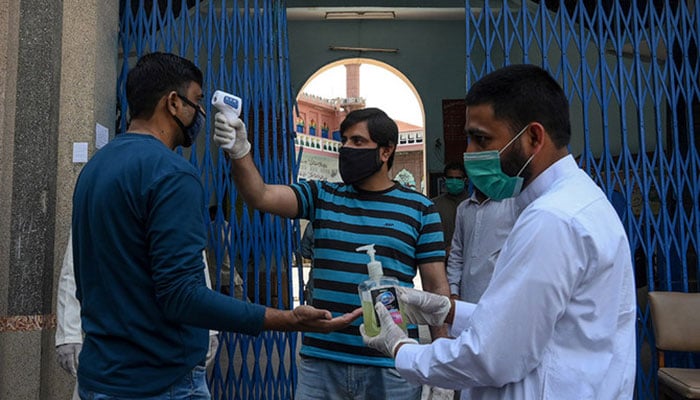
However, there are numerous complaints by relatives/family members of critical COVID-19 patients vis-à-vis denial of admission to the ICUs and HDUs as well as non-availability of ventilators in teaching hospitals.
The patients are forced to go to private hospitals/local clinics for treatment. “My elderly father, who requires ICU bed and ventilator due to severe coronavirus condition, has been denied admission at Mayo Hospital, Sir Ganga Ram Hospital, Services Hospital and Jinnah Hospital due to lack of space,” a patient’s son Zafar Ali told The News, adding that the government had left the serious patients to die.
Another female COVID-19 patient’s family complained that the ICU beds and ventilators were not even available in private hospitals in Lahore.
“The healthcare system for terminally-ill COVID-19 patients has choked due to paucity of the ICU and HDU beds and ventilators in public sector hospitals of Punjab,” said Dr Shahid Shaukat Malik, General Secretary Pakistan Medical Association (PMA), Lahore, while talking to The News.
The government is trying to show the isolation bed strength as critical care facilities. He termed Punjab government’s act of establishing field hospitals “a waste of money”, saying that the home isolation policy had rendered the Field Hospitals and Isolation Wards in teaching hospitals empty.
Instead of wasting public exchequer on Field Hospitals, Dr Shahid Malik said, the Punjab government could have easily used trust hospitals like 1,500-bedded Gulab Devi Hospital, being run on government’s grants, and attached teaching hospitals of private medical colleges equipped with infrastructure, ICUs, ventilators and oxygen. “There are 3,500 ventilators in Punjab, out of which 2,200 are in private sector, yet these private health facilities are lying empty and government chose to spend on field hospitals,” he lamented.
Dr Malik said that at least, 2,100 medical professionals had been infected with coronavirus and 22 died from the virus in Pakistan so far.
Young Doctors Association (YDA), Punjab President Dr Salman Haseeb Chaudhry, who himself has been diagnosed COVID-19 positive, said the critical care health facilities across Punjab had exhausted and human resources exposed to the virus. He lambasted the government for exposing the doctors and medical staff to the virus by denying personal protective equipment (PPE), followed by opening of lockdown to trigger the spike. “The government is not conducting tests of the medical professionals,” he informed while expecting, at least, 10 to 15 per cent of medical staff in hospitals to be diagnosed with coronavirus.
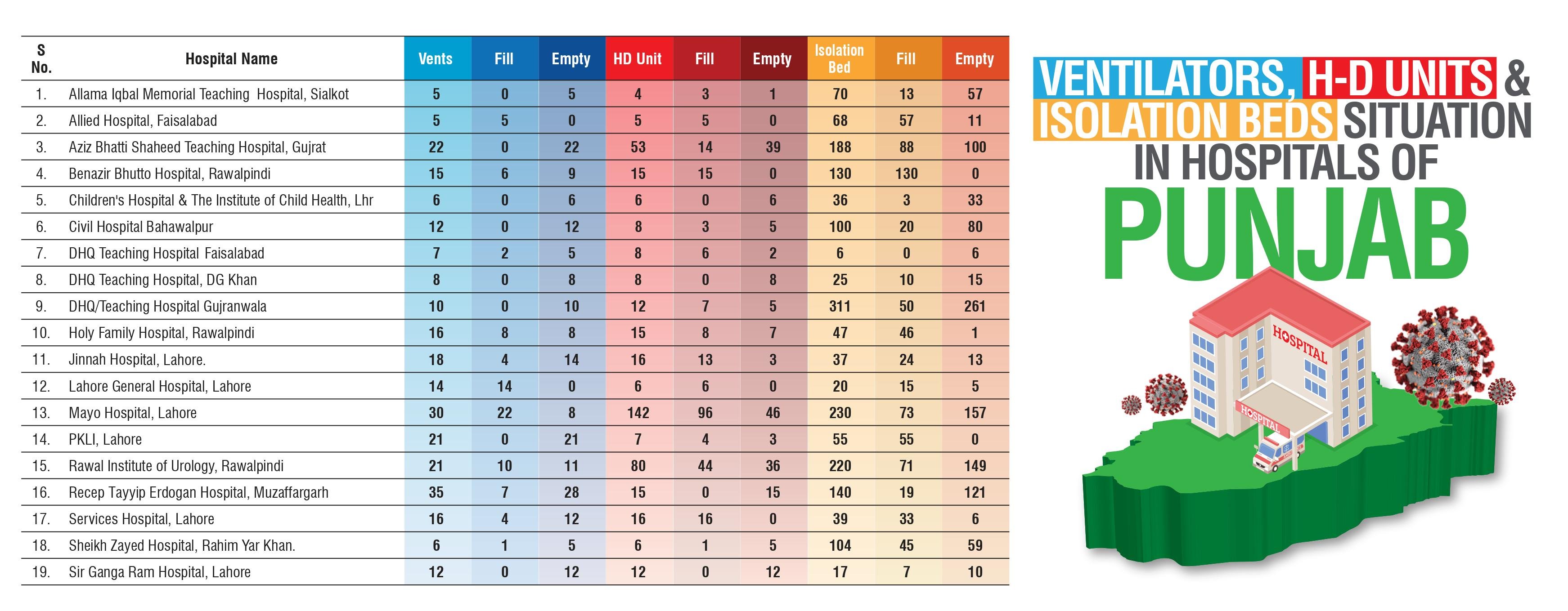
However, contrary to claims of doctors and COVID-19 patients, the Health Department’s official data says that, out of 29,015 dedicated beds for COVID-19 patients in Punjab, 6,237 have been dedicated for critical COVID-19 patients including 4,900 in Isolation Wards, 760 in High Dependency Units (HDUs) and 577 in single-bedded Isolation Rooms in public, private and field health facilities in the province. Out of total beds, 1,500 are occupied, while 4,737 are still lying vacant.
Similarly, out of 679 dedicated ventilators for critical COVID-19 patients, 94 are occupied, and 585 are still available.
As per the break-up of bed strength dedicated for COVID-19 patients in tertiary care hospitals in Punjab, there are 108 dedicated COVID-19 beds out of 410 in Civil Hospital Bahawalpur, 25 out of 1538 in Bahawal Victoria Hospital, Bahawalpur, 97 out of 954 in Shaikh Zayed Hospital, Rahim Yar Khan, 33 out of 540 in DHQ Teaching Hospital, DG Khan, 200 out of 250 in Recep Tayyip Erdogan Hospital, Muzaffargarh, 12 out of 850 in DHQ Teaching Hospital Faisalabad, 31 out of 1500 in Allied Hospital, Faisalabad, 8 out of 250 in Children Hospital Faisalabad, 6 out of 250 in Faisalabad Institute of Cardiology, Faisalabad, all 250 beds are dedicated as COVID-19 in General Hospital Ghulam Muhammad Abad, Faisalabad, 307 out of 450 in DHQ/Teaching Hospital Gujranwala, 241 out of 492 in Aziz Bhatti Shaheed Teaching Hospital, Gujrat, none in 100-bedded in Wazirabad Institute of Cardiology, Wazirabad, 94 out of 400 in Allama Iqbal Memorial Teaching Hospital, Sialkot, 4 out of 134 in Govt Sardar Begum Teaching Hospital Sialkot, 20 out of 149 in Kot Khawaja Saeed Teaching Hospital, Lahore, 6 out of 547 in Punjab Institute of Cardiology, Lahore, none in 1510-bedded Punjab Institute of Mental Health, Lahore, 11 out of 235 in Lady Willingdon Hospital, Lahore, 24 out of 908 in Sir Ganga Ram Hospital, Lahore, none in 30-bedded Punjab Dental Hospital, Lahore, 43 out of 1450 in Services Hospital, Lahore, 338 out of 2484 in Mayo Hospital, Lahore, 3 out of 100 in Govt. Said Mitha Teaching Hospital, Lahore, all 280 beds are dedicated as COVID-19 in PKLI, Lahore, 14 out of 195 in M. N. Sharif Teaching Hospital, Yakki Gate, Lahore, 12 out of 200 in Lady Aitchison Hospital Lahore, 42 out of 1100 in Children Hospital Lahore, 9 out of 300 in Government Teaching Hospital Shahdara Lahore, 31 out of 45 in Govt. Mozang Teaching Hospital Lahore, 30 out of 1000 in Lahore General Hospital, Lahore, 24 out of 149 in Govt. Mian Munshi DHQ-I Teaching Hospital Lahore, 55 out of 1500 in Jinnah Hospital, Lahore, none in 500-bedded PINS Lahore, 104 out of 1700 in Nishtar Hospital, Multan, 24 out of 300 in Children Complex Multan, none in 279-bedded Ch. Pervaiz Elahi Institute of Cardiology Multan, 24 out of 360 in T.B Sanatorium Samli Murree, all 400 beds are dedicated as COVID-19 in Rawal Institute of Urology, Rawalpindi, 7 out of 272 in Rawalpindi Institute of Cardiology, 10 out of 357 in DHQ Teaching Hospital, Rawalpindi, 135 out of 738 in Benazir Bhutto Hospital, Rawalpindi, 40 out of 962 in Holy Family Hospital, Rawalpindi, 41 out of 377 in DHQ Hospital, Sahiwal, 100 out of 120 in Govt. Haji Abdul Qayyum Teaching Hospital, Sahiwal, and 94 out of 731 in DHQ Teaching Hospital, Sargodha.
Provincial cabinet, in its 27th meeting held on March 12, 2020, declared an emergency in Punjab due to the Corona Virus Disease (COVID-19) and relaxed the PPRA rules.
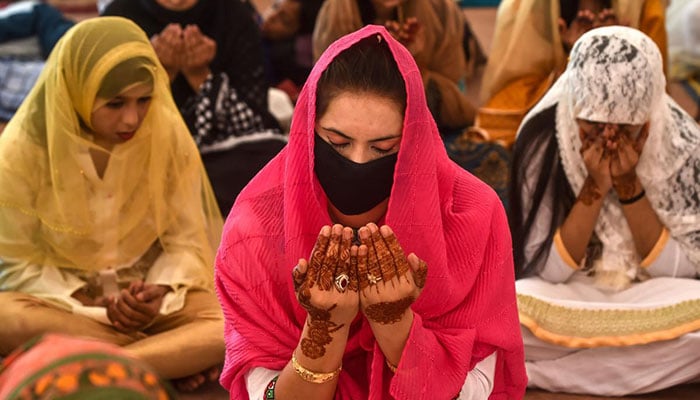
The SHC&ME provided financial support to the hospitals to Combat COVID-19 including a fund of Rs966 million to the hospitals out of which Rs400 million were utilised by hospitals and another Rs140 million spent on PPEs so far. Further required funds are being provided to the hospitals on need basis.
When contacted by The News, Secretary SHC&MED Nabeel A. Awan admitted that after easing of the lockdown, the patient load hit the health facilities more quickly. However, as of now, he said, there is no capacity issue in hospitals, because according to occupancy data, the ICU/HDU beds and ventilators are still vacant in many hospitals. “But we can’t predict as to how many days we can cope with it because with the opening up of lockdown completely and people behaving irresponsibly, we may soon start facing capacity issues,” he added.
However, he said, the department had prepared a contingency plan to rope in five trust hospitals including Gulab Devi Hospital, running with government’s grants, and private teaching hospitals to share the burden of COVID-19 patients’ critical care.
To a question regarding home isolation policy rendering Field Hospitals and Isolation Wards in hospitals empty, he admitted that the asymptomatic COVID-19 patients, having isolation facilities in their homes, have opted for home isolation. “Currently, there are 1,200 to 1,250 patients are home-isolated,” he said, adding that presently there are less than 100 patients in Field Hospital at Expo Centre Lahore.
When asked if it was really needed to set up Field Hospitals sans critical care despite the option of trust hospitals and private teaching hospitals equipped with critical care facilities, he said that the required medical facilities in these hospitals were too little to cope with COVID-19 emergency.
When asked about infections among medical professionals and plan to conduct mass testing of medical staff in hospitals, he said that the government had already increased testing among doctors and medical staff. “We are in the midst of a pandemic and have to face these challenges, yet at the same time, we must protect our frontline soldiers in the fight against coronavirus,” he added.
To a question regarding discrepancies in COVID-19 mortalities in statistics of P&SH and SHC&ME departments, he said that the COVID-19 data of both departments was collectively compiled by the P&SH Department. “If there’s any discrepancy in mortality figures between the two departments, it could be not because of human error but because of some technical IT glitch,” he added.
Balochistan: Only Quetta has the facilities to treat coronavirus patients
Balochistan is not so badly affected by COVID-19 as the other provinces are because of its thin population and scattered localities, but, according to the Health Department, 51 people have so far died from COVID-19 in the province.
Former Chief Justice of Balochistan Ghulam Mustafa Mengal, his wife, three doctors, MPA Syed Fazal Agha, former minister Sardar Tareen, SP Ch Mushtaq, two senior paramedic brothers and the father of an additional secretary are among the coronavirus victims.
Lack of health facilities in government hospitals to blame for health crisis in the province. Interior Balochistan face shortage of hospitals and clinics due to which hospitals in Quetta are overburdened. Even the patients of minor of ailment are referred to the city.
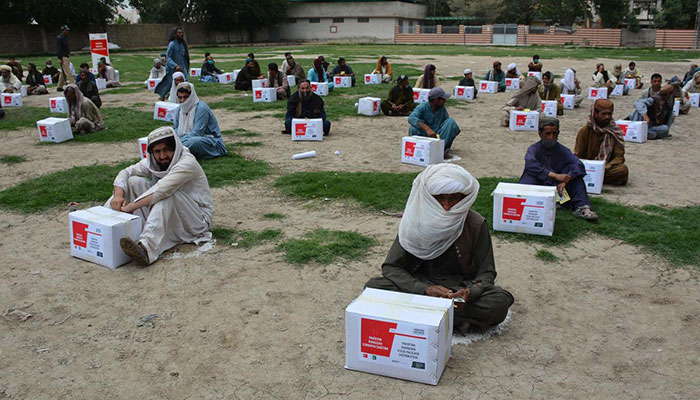
There are 5,224 corona patients in the province. Around 27,301 tests were conducted and 22,940 people tested positive for the virus whereas 24,530 are corona suspects in the province while 2,021 patients defeated the infection. Areas of interior Balochistan face shortage of quality government hospitals and dispensaries due to which patients come to the provincial metropolis for their treatment. Besides Quetta, COVID-19patients are being treated at Fatima Jinnah TB Sanatorium Chest Hospital and Sheikh Zaid Hospital in the outskirts of Quetta whereas corona tests are being conducted in Quetta and Taftan.
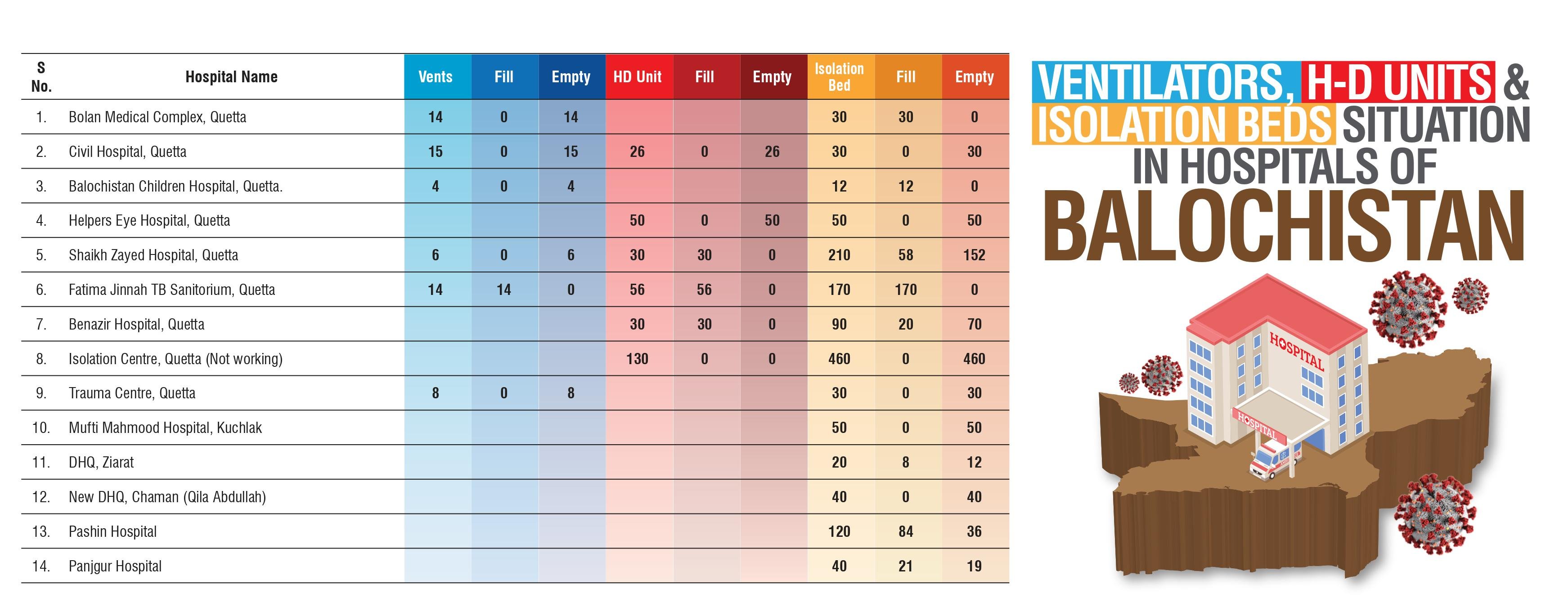
There are 1,062 beds in Bolan Medical Complex in Quetta where 30 virus patients are being treated. There are 14 ventilators at BMC Hospital and no patient was on the ventilator. Civil Hospital has 850 beds and 30 beds have fixed for corona patients and 26 patients are being treated for the disease in this hospital. There are 15 ventilators in Civil Hospital. There are 132 beds in Children Hospital and 12 corona patients are being treated in this hospital.
The areas in interior Balochistan do not have enough arrangements to treat corona patients. Residents of these areas are referred to Quetta. The cases of corona are increasing in Quetta and other areas of the province.
Doctors in the province are afraid of the infection and are not working. On the other hand, with the closure of OPDs in hospitals, patients are suffering a lot. People suffering from other diseases find no doctors in these hospitals and they fear, if OPDs are not opened thousands of people may die. They demanded for opening of OPDs in hospitals of the province. With the closure of OPDs, thousands of patients of other aliments are at risk of dying.
Islamabad: Limitations resurfacing with increasing patient load in federal capital
Even though Islamabad is not listed among the country’s top-seven cities in terms of the total number of COVID-19 cases and deaths, the city remains conspicuous for reporting the highest number of COVID-19 cases per million population, and the third-highest number of coronavirus induced deaths per million population in the country, The News has reliably learnt.
According to officially documented data exclusively available to this scribe, Islamabad had—as of June 3—reported 2,610 cases per million population. Although seemingly an insignificant number, the fact that a majority of the county’s overall population—the residents of Islamabad being no exception—is petrified by the thought of self-volunteering for testing and resultantly remain undiagnosed, adds a menacing dimension to these trends.
Islamabad also ranks third among the top-seven cities in terms of COVID-19 deaths per million population. The city reported 26 deaths/ million as of June 3, preceded only by Malakand with 31 deaths/million and Peshawar topping the list with 50 deaths/million. Karachi ranks 4th with 25 deaths/million, followed by Rawalpindi, Lahore, and Swat, with 23, 19, and 19 deaths per million, respectively.
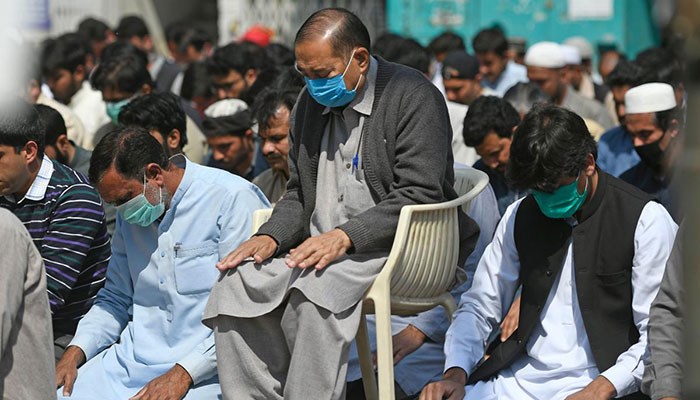
With 21,000 tests per million, Islamabad is also way ahead of any other city in terms of the number of tests being conducted. “This is one of the biggest reasons for higher number of cases. When we don’t test, we don’t get numbers, as has been the case in Punjab,” remarked a data analyst. Moreover, the Islamabad Capital Territory (ICT) is also learnt to have embarked on a seroprevalence survey for identification of the actual number of residents exposed to COVID-19. The survey is based on antibody testing in blood. The total number of tests undertaken in Islamabad exceeded 43,500 on June 4 as the number of confirmed cases in the city touched 3,544, with 3,201 active cases, 302 recoveries, and 41 deaths as of June 4. Weekly data of confirmed cases in Islamabad also depicts a progressive increase with enhancement of the country’s testing capacity. According to available data, Islamabad reported four confirmed cases during the week March 10-16; 11 cases during March 17-23, and 39 cases during March 24-31. The first week of April witnessed 38 cases—one short of the previous week’s 39. This has thus far been the only week when the number declined, although inconsequentially. Fifty-three confirmed cases were reported during April 8-15, followed by 69 during April 16-23 with the addition of 16 new cases. The number of cases then substantially increased from 69 to 129 during April 24-30, with another 86 cases the following week taking the total to 215 during May 1-7. In the three weeks that followed, the number of cases increased from 363 (May 8-15) to 671 (May 16-23) and then 997 during the last week of May.
A province-wise breakup of critical beds’ allocation and occupancy (with oxygen) for COVID-19 patients, as of June 3, portrays Islamabad as being enviably self-sufficient with only 14 of 248 allocated beds occupied. These numbers defy facts as PIMS alone had 58 COVID-19 admissions on June 4 alone—13 of them on ventilators.
As far as ventilator utilisation for COVID-19 patients is concerned, only 12 (13%) of the 92 allocated ventilators are currently being utilised by patients admitted in Islamabad’s hospitals while 80 lay vacant.
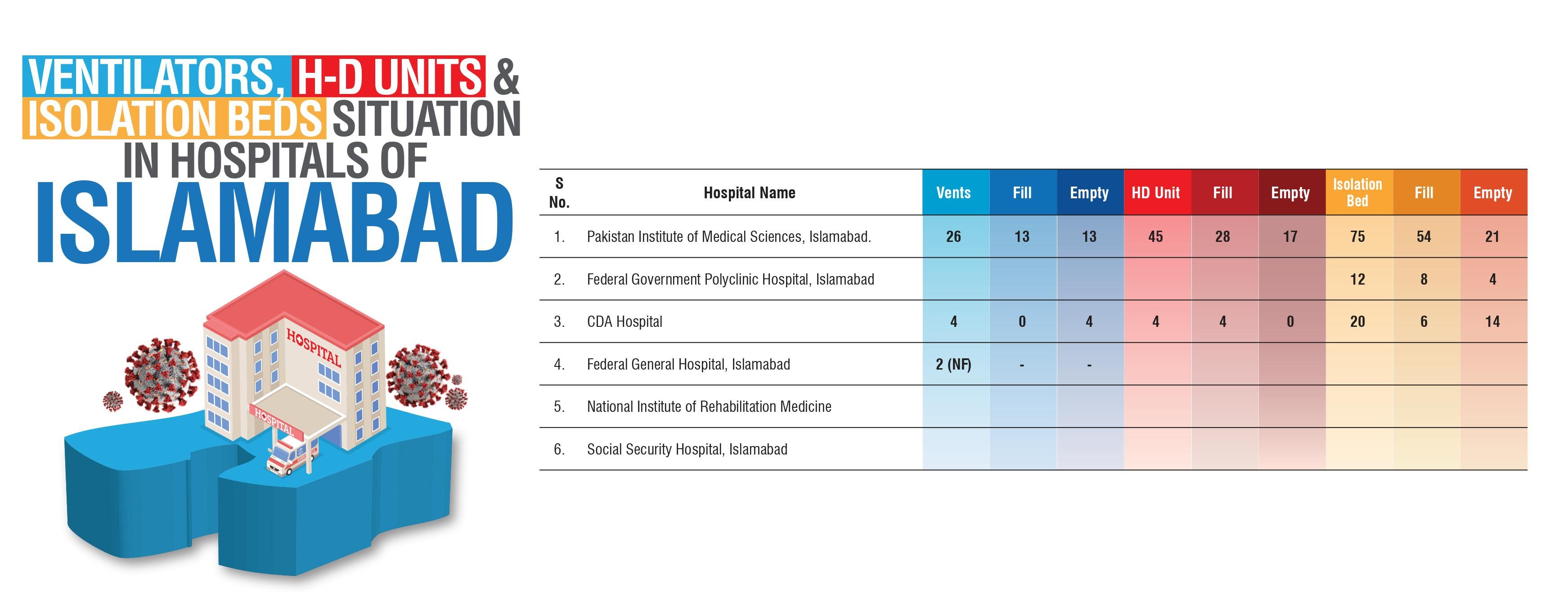
According to national data, the number of patients on oxygen has always been in excess of those requiring ventilatory support. In the last one month, for instance, the number of patients on oxygen rose from 111 on May 3 to 606 on June 3, while those on ventilators skyrocketed from 36 on May 3 to 231 on June 3.
Frontline healthcare providers and workers affected by COVID-19 in Islamabad, as of June 3, comprise 106 doctors, 50 nurses, and 61 paramedics and other staff. At the national level, 2,561 healthcare personnel had tested positive as of June 3; these comprised 1,510 doctors, 352 nurses, and 699 health staff, with 937 recoveries constituting 37% of the total.
Hospital-based data acquired by The News show that the Pakistan Institute of Medical Sciences (PIMS), which is all set to become the only tertiary care government hospital dedicated to the management and treatment of COVID-19 patients in Islamabad, is equipped with 85 ventilators in its different ICUs (Medical ICU, Surgical ICU, Coronary Care ICU, Pediatric ICU, Neonatal ICU, and MCH Centre). Of the total ventilators, 26 are exclusively reserved for COVID-19 patients, 13 are currently in use, and an equal number is vacant. Two of the vacant ventilators are reserved for pediatric patients. According to the hospital’s Joint Executive Director Dr. Minhaj-Us-Siraj, PIMS houses 45 High Dependency Unit (HDU) beds for COVID-19 patients, of which 28 were occupied and the remaining 17 were vacant as of June 4. All 30 isolation beds at PIMS are also occupied by COVID-19 patients. Even though initial capacity-related issues have been overcome, some limitations are resurfacing with increasing patient load. The Deputy Director of the evening shift at PIMS Dr. Fahim hoped that the NCOC-devised Resource Management System, which will offer real time data regarding availability of beds, ventilators, and hospital-based facilities for COVID-19 patients, is quickly operationalised so that patients who cannot be accommodated at PIMS at a given time are referred to some other facility.
While the management and treatment of COVID-19 patients is itself grueling and arduous, health personnel are beset with a variety of additional challenges. The in-charge nurse at PIMS, for instance, termed acute shortage of nursing and support staff in the COVID-19 ICU as disconcerting and feared that the health human resource crisis in Islamabad would only exacerbate in the weeks and months ahead.
“We currently have only 18 ICU nurses performing duties in three shifts (6 nurses per shift), as against a requirement of 60 nurses (20 per shift) per day,” the ICU nurse pointed out, tabling her wish list. Immediate measures, nonetheless, must be instituted to overcome the widening human resource gap as the number of cases increases. Moreover, there are no replacements when nurses fall ill or are too exhausted to serve. “Should symptoms pop up, they take relevant meds, gargle, and return to their patients in the hope of being replaced, which is seldom the case,” said the in-charge nurse.
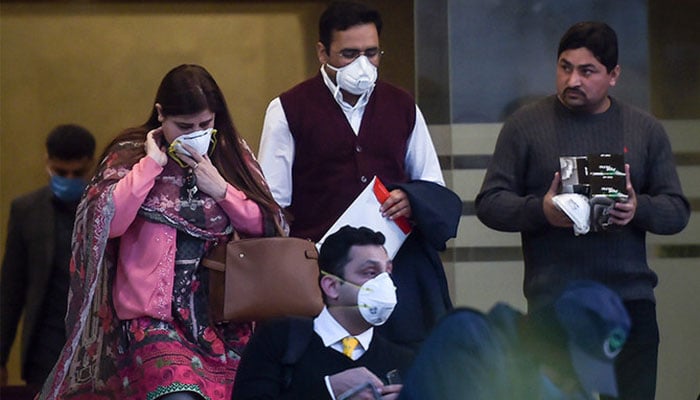
At Polyclinic, doctors and nurses claimed facing two types of risks—the risk of acquiring infection from COVID-19 patients, and the risk of physical altercations by attendants. “Forty health personnel in Polyclinic and around 90 in PIMS have tested positive thus far. With a growing number of medics acquiring the infection, the health system’s capacity to tackle this emergency has already begun to dwindle,” stated a doctor (requesting anonymity) working in Polyclinic’s Coronavirus Isolation Ward.
In a related development, a policy decision has reportedly been taken to disband the 12-bedded Coronavirus Isolation Ward of Polyclinic and to shift all confirmed patients to PIMS. Verbal instructions against admission of new COVID-19 patients at Polyclinic were issued on June 4 although an official notification is still awaited. With two COVID-19 patients discharged on June 4, only eight admissions now remain in the said hospital.
The Capital Hospital’s 20-bedded Corona Isolation Ward is equipped with four ventilators. Six COVID-19 patients were admitted at the hospital as of June 4—almost all of them are being managed for comorbid conditions. Critically ill patients requiring HDU beds are referred to PIMS. The hospital reported ample supplies of PPEs and medicines following some hiccups in the initial days of the epidemic. Shortage of doctors, nurses, paramedics, technicians, and staff is a key constraint, which is expected to be overcome with 200 recruitments (including 50 doctors and nurses each) for which an advertisement would be afloat within the next couple of days, The News reliably learnt.
The Federal General Hospital (FGH)—which was envisaged as a tertiary care facility at the time of its establishment—is ill-equipped to accommodate COVID-19 patients in the event of a larger medical emergency. The hospital currently has a 4-bedded ICU only. “We referred around 20 suspected patients to PIMS during the last one week,” the Deputy Director of FGH Dr. Mir Hassan confirmed. Responding to a query about availability of ventilators, he said, “Secondary care hospitals like ours are not supposed to have ventilators.” The FGH currently has only two vents—both non-functional.
With reference to capacity-building of health professionals, Dr. Shahzad Ali Khan, Head of the Public Health Department of the Health Services Academy (HSA) shared that HSA has initiated a series of ‘Basic Assessment and Support in Intensive Care’ (BASIC) trainings on ICU care in several cities including Islamabad, Karachi, Lahore, Quetta, Gilgit-Baltistan, and Nawabshah. The curriculum of the trainings, which will be imparted by CPSP-certified intensivists, has been adopted from the Chinese University of Hong Kong. The course is meant for ICU doctors, nurses, and technicians of all 600 government and private hospitals listed as COVID-19 facilities by the National Disaster Management Authority.
As the grip of COVID-19 tightens around Islamabad, it is the shortage of doctors, nurses, technicians, and support staff in the city’s public sector hospitals that remains a key concern. “Our predicament should be a clarion call for the government—how long will it be before we too succumb to mounting pressure,” was the overriding takeaway apprehension expressed by medics and staff alike during interviews with this scribe.
Khyber Pakhtunkhwa: Govt enhances facilities to cope with rising cases
The rise in the number of coronavirus patients and fatalities has prompted the Khyber Pakhtunkhwa government to increase the number of health facilities across the province to cope with the coronavirus pandemic.
Presently, 10 major hospitals of KP are treating coronavirus patients. These hospitals have dedicated 452 beds of the intensive care units (ICUs) and high dependency units (HDUs) for coronavirus patients. However, the available space is shrinking fast due to increasing number of coronavirus patients. The wards at hospitals have been kept at standby for converting them into ICUs for corona patients if needed.
The 110 other small and large hospitals in the province have established isolation wards comprising 856 beds. KP has got the capability of testing 2,860 corona patients daily. So far, 11,890 patients have tested positive in KP, while 521 have lost their lives, according to data available till Thursday. The death ratio in KP is about 5 percent, which is comparatively higher than other provinces. However, beds and ventilators are available for patients.
Official documents say 140 beds are available for ICU for COVID-19 patients in which 99 patients are admitted, while 41 beds are still unoccupied. Similarly, 312 beds are available in HDUs in which 210 patients are admitted and 102 more patients can be accommodated.
KP Health Minister Taimur Jhagra said the KP government constantly changes its plan to deal with the emergency according to emerging situations. He told The News that the most serious patients are shifted to ICU, relatively less serious patients are kept at HDU and routine patients are kept at normal wards. He said the situation in KP is under control, but people will have to observe precaution.
In the Hayatabad Medical Complex (HMC) Peshawar, out of 20 ICU beds, 19 are occupied and one is empty. In HDU 65 patients are admitted while total beds are 66. For general patients, there are 19 ICU beds in HMC and 12 of these are occupied. For general patients, there are 800 beds in the hospital and 380 of these are occupied. There are 42 dedicated beds for the hospital’s quarantine centre and 17 of these are occupied. 25 ventilators are available for corona patients and 19 of these are under use, while 19 ventilators are available for other patients.
In Khyber Teaching Hospital (KTH) Peshawar, out of 11 ICU beds, eight are occupied and three are empty. In HDU 57 patients are admitted while total beds are also 57 which means it is filled to capacity. For general patients, there are 1,225 beds in the hospital and 342 of these are occupied. There are 20 dedicated beds for the hospital’s quarantine centre and 10 of these are occupied. As per official data, out of 56 ventilators, 25 are reserved for coronavirus patients.
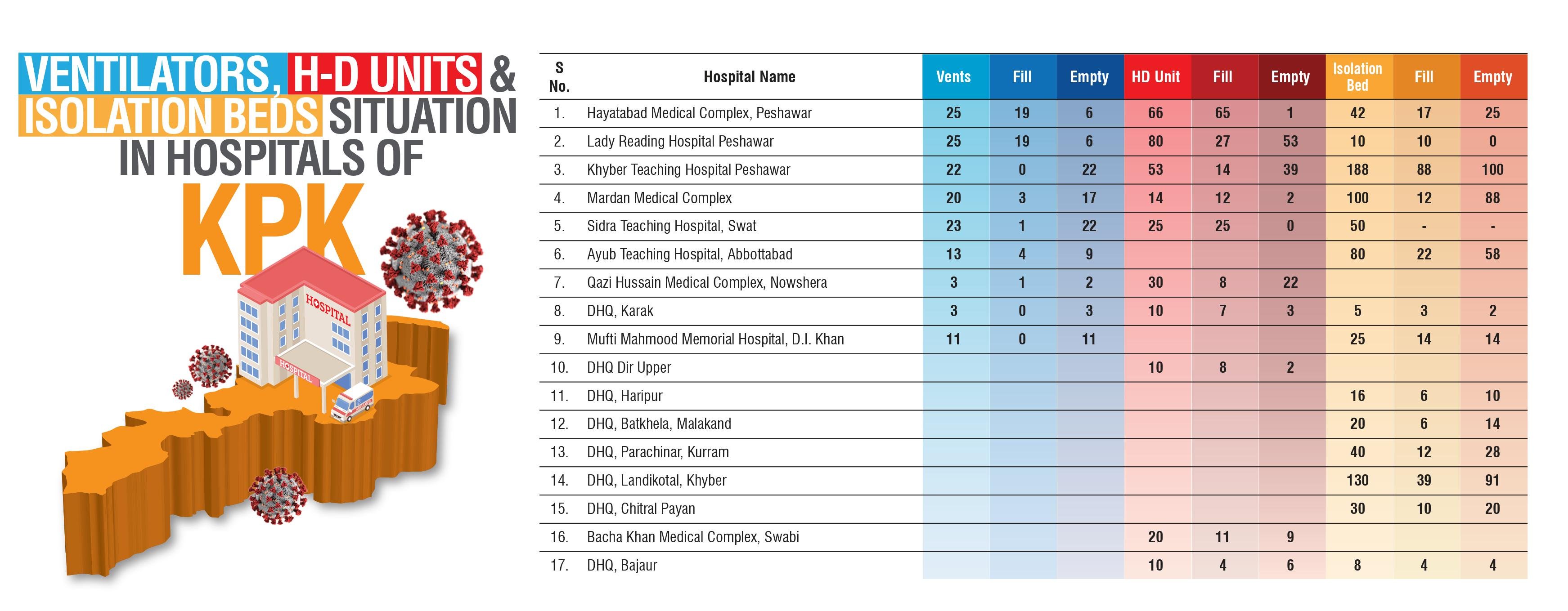
The KP government hospitals have made available 508 ventilators for corona patients, while 179 ventilators are also available at private hospitals.
In the Lady Reading Hospital (LRH) Peshawar, out of 25 ICU beds, 23 are occupied and two are empty. In HDU 27 patients are admitted while total beds are 80. For general patients, there are 18 ICU beds in LRH and 13 of these are occupied.
The LRH as the biggest hospital in KP has the largest number of beds in ICUs and ventilators. The hospital has 43 ventilators in which 25 are meant for the COVID-19 patients.
In Saidu Teaching Hospital (STH) Swat, out of 25 ICU beds, 16are occupied and nine are empty. In HDU 25 patients are admitted while total beds are also 25 which means it is filled to capacity. Out of 23 ventilators, only one is under use.
Mardan Medical Complex (MMC) from its 344 beds capacity has mostly been accommodating COVID-19 patients. Since the outbreak of the pandemic, MMC was one of the few hospitals that accommodated COVID-19 patients brought it to from Manga village, where the virus was first reported in KP. The first patient, Saadat Khan who died due to COVID-19 in Pakistan also belonged to Manga.
Though MMC had reserved 100 beds for corona patients, on which 12 patients are admitted. In its 16 beds ICU for corona patients, 13 are occupied. In HDU’s 14 beds, 12 are occupied. Out of 20 ventilators, only three are under use.
Ayub Teaching Hospital (ATH) Abbottabad has 1,250 total beds, 442 patients are admitted. ATH has reserved 91 beds for corona patients. It has 25 ventilators and 13 are meant for COVID-19 patients and only two of them are under use. There are 12 ventilators for general patients and seven of them are under use.
As per official data shared by the KP health department, there is no ventilator available for COVID-19 patients in Bajaur tribal district, Lower Kohistan, Upper Kohistan, Lakki Marwat, Mansehra, Nowshera, Haripur, etc. In most of the districts, the hospitals either don’t have ventilators or have failed to reserve any for corona patients.
However, and HDU has been set up in Bajaur having capacity of 10 patients and four patients are under treatment there.
DHQ Hospital Upper Dir also doesn’t have ICU. However, it has a 10-bed HDU where eight patients are admitted.
In DHQ Hospital Karak, there is a 15-bed ICU for corona patients, but no patient is admitted there. HDU has 10 beds where seven patients are admitted. Five isolation beds have also been set up for corona patients and three of these are occupied.
In Bacha Khan Medical Complex Shah Mansoor, Swabi, out of 16 ICU beds, only one is occupied. In HDU 11 patients are admitted while total beds are 20. There are 16 ventilators for corona and 10 for other patients and none of these is under use.
In DHQ Hospital Battagram, out of 10 ICU beds, five are occupied.
In DHQ Hospital Batkhela, out of 20 beds for corona patients, six are occupied.
There are 24 isolation beds for corona patients in DHQ Hospital Lower Dir and 13 are occupied. For general patients, there are 380 beds and 250 are occupied.
In DHQ Hospital Kurram, out of 40 beds for corona patients, 12 are occupied.
In DHQ Hospital Haripur, six out of 16 isolation beds for corona patients are occupied.
Qazi Medical Complex Nowshera one ventilator out of three for corona patients is under use. There are 16 beds for corona patients and four of these are under use.
There are 25 isolation beds for corona patients in Mufti Mehmood Memorial Hospital DI Khan and 14 are occupied. For general patients, there are 380 beds and 250 are occupied. No ventilator out of 11 is under use.
In DHQ Hospital Lower Chitral, 10 out of 30 isolation beds for corona patients are occupied, while in DHQ Hospital Landikotal, 39 out of 130 isolation beds for corona patients are occupied.
Also, the KP government has arranged investigations for COVID-19 patients in 14 laboratories. Most of the labs are in the province while two are in Islamabad.
They include Khyber Medical University (KMU), Peshawar, Hayatabad Medical Complex (HMC), Peshawar, Khyber Teaching Hospital (KTH) Peshawar, Mardan Medical Complex (MMC), Saidu Teaching Hospital (STH) Swat, Khalifa Gul Nawaz Hospital, Bannu, the private sector Rehman Medical Institute) Peshawar, Northwest General Hospital, Peshawar, Anwar Lab, Shahina Jameel Hospital, Abbottabad, and National Institute of Health (NIH), Islamabad and Islamabad Diagnostic Centre.
In KP, 545 ventilators are available, including 365 in the public sector hospitals and 179 in the private hospitals.
KP has so far lost 520 people to coronavirus and recorded 10,897 positive cases.
There are eight dedicated hospitals for coronavirus patients in Peshawar city district, including the three tertiary care hospitals - Lady Reading Hospital (LRH), Khyber Teaching Hospital (KTH) and Hayatabad Medical Complex (HMC). Others are the Type D Hospital Nahaqi, Type D Hospital Badaber, Naseerullah Khan Babar Memorial Hospital, Type D Hospital Ghara Tajik, and Type D Hospital Mattani.
Swat is the second most affected district from corona in KP after Peshawar. It has lost 45 people so far and reported 892 positive cases.
Eight hospitals in Swat are dedicated for the treatment of coronavirus patients. The biggest health facility in Swat is the tertiary care Saidu Group of Teaching Hospital, which is in the public sector. It has 1,104 beds in which 100 have been reserved for COVID-19 patients. It is the only teaching hospital in the Malakand Division which has eight districts including Swat.
Out of 29 ventilators available at the Saidu Group of Teaching Hospital, 23 are meant for the COVID-19 patients. Other hospitals in Swat are Kabal Hospital, Isolation Centre in Matta which is the hometown of Chief Minister Mahmood Khan, Barikot Isolation Centre, Nawaz Sharif Kidney Hospital, Manglawar Swat, CH Khwazakhela, CH Madyan, and CH Kalam. Except the teaching hospital in Saidu Sharif, there is no ventilator available in the other hospitals in Swat. Two private hospitals are also offering services to the corona patients in Swat. One hospital has two ventilators. One of the ventilators has been dedicated to the COVID-19 patients.
In Mardan, there are two public sector hospitals - Mardan Medical Complex (MMC) and District Headquarters Hospital (DHQ) that provide services to coronavirus patients. In Abbottabad, there are three public sector hospitals dedicated for accommodating corona patients. These are Ayub Teaching Hospital (ATH), BBS (DHQ) Abbottabad, and Type D Hospital, Havelian.
In Bannu, the 230-bed Khalifa Gul Nawaz Teaching Hospital has dedicated 20 beds for corona patients. It has 15 ventilators, including seven reserved for the critical corona patients.
Header and thumbnail image: A railway worker wearing a protective gear measures the temperature of a passenger before boarding a train in Karachi, Pakistan — Reuters


